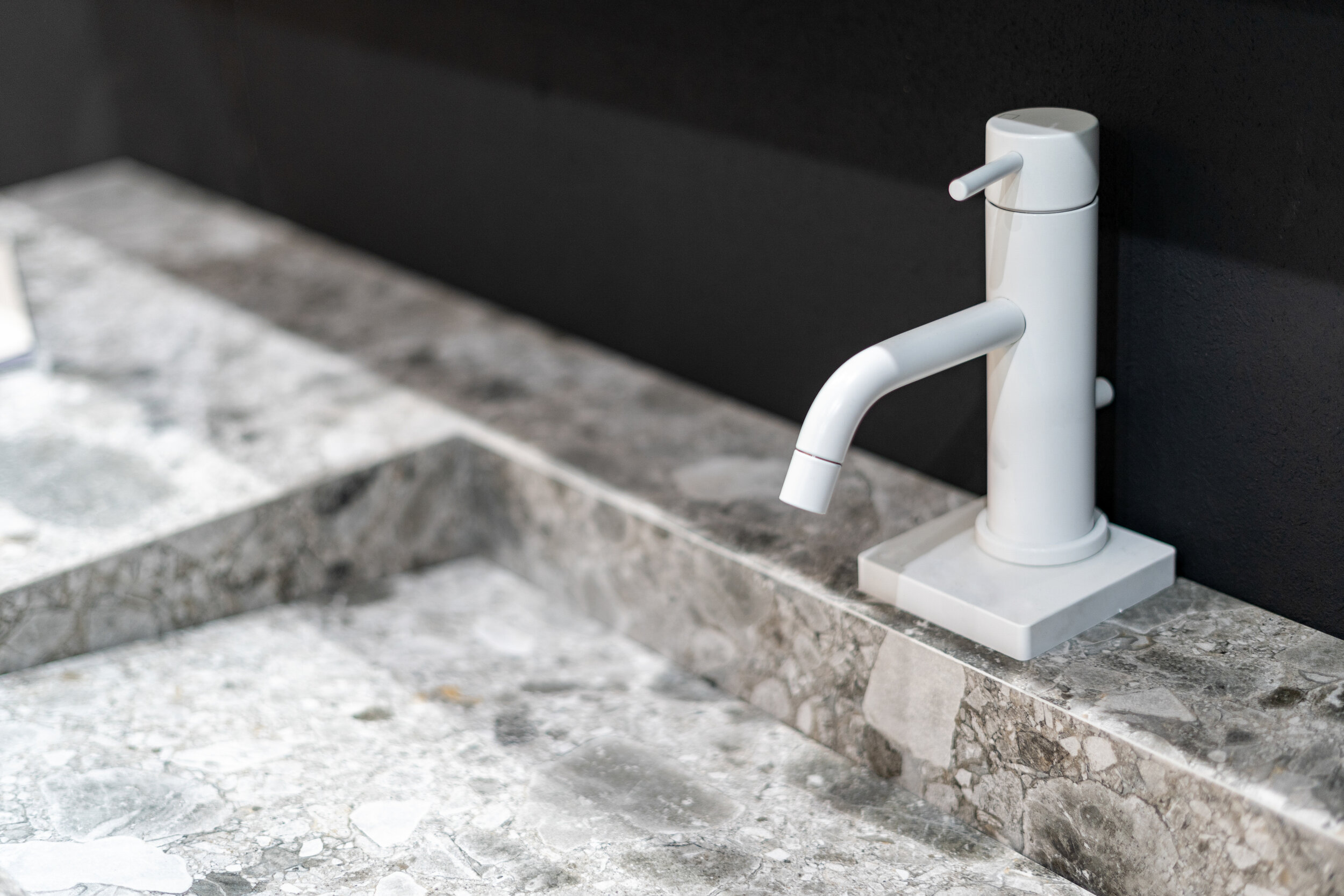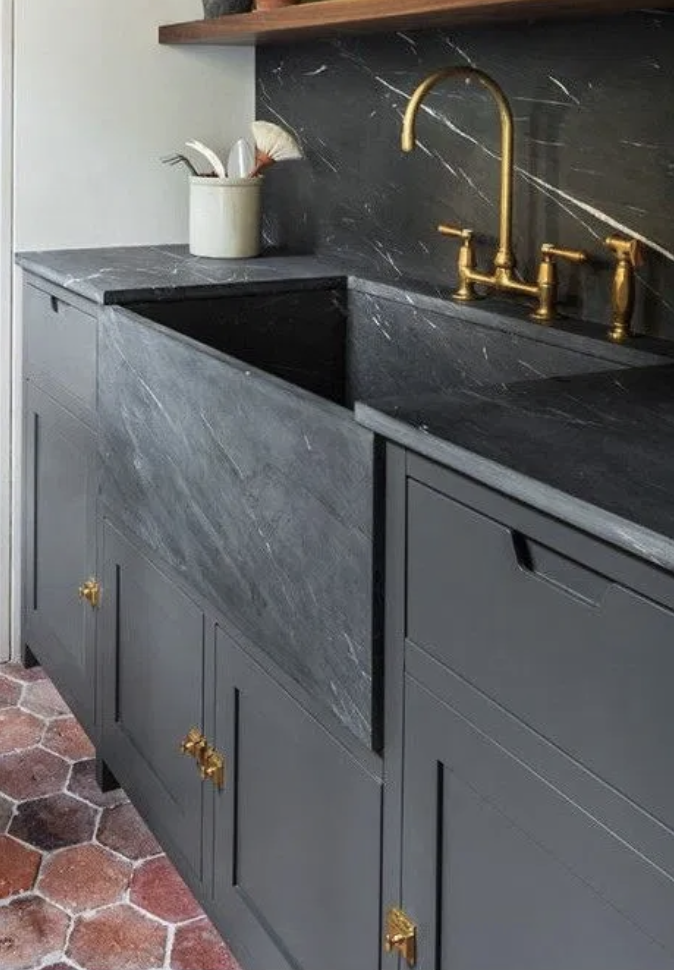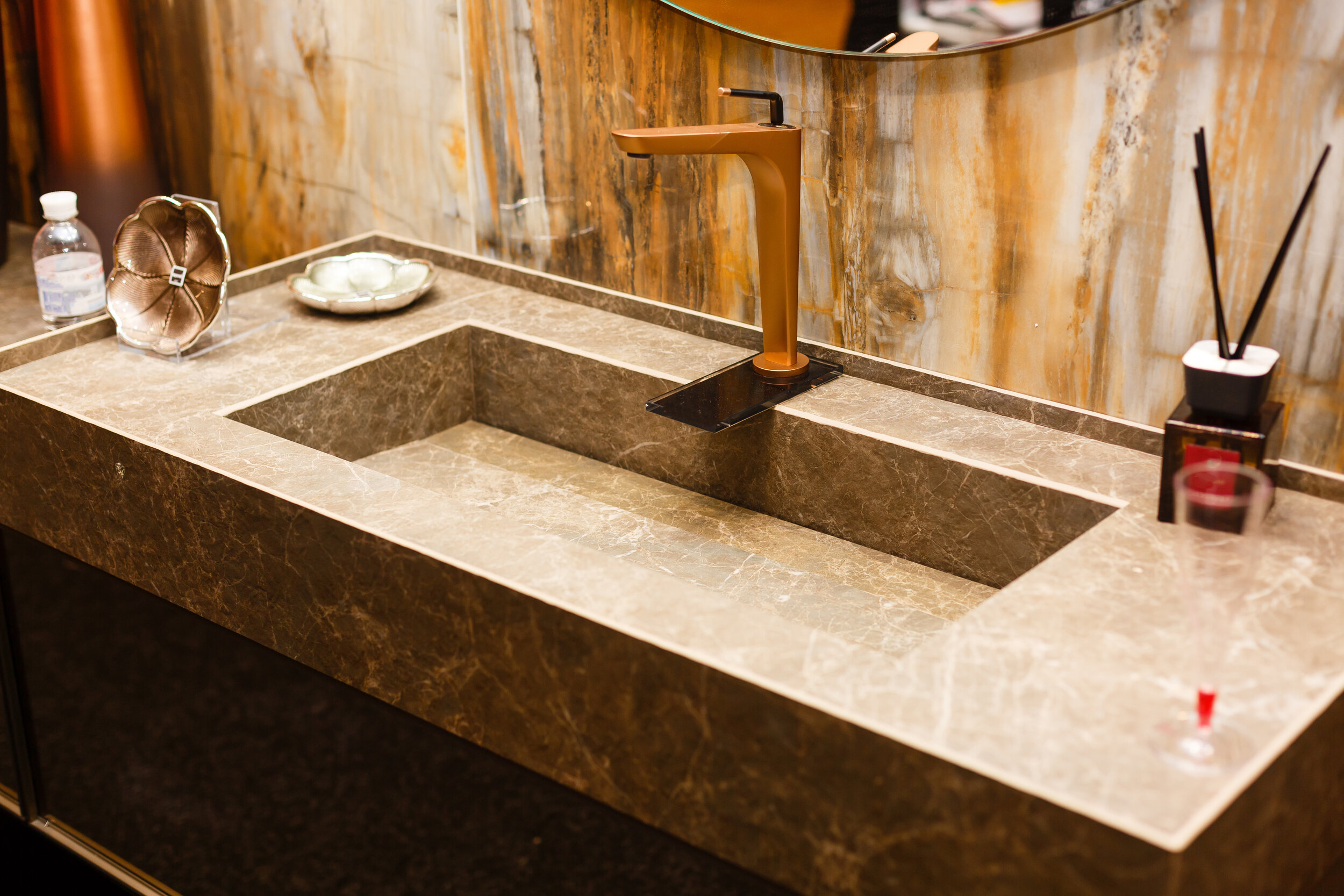How to Spec Natural Stone Countertops for Commercial Construction Projects
Find centralized info on how to specify natural stone countertops, such as marble, granite, quartzite, and more, for commercial construction projects.
Image courtesy of Pental
Natural stone is a beautiful, organically produced material product, commonly used for countertops, reception desks, feature walls and more. It is created by a combination of earth’s thermal heat and extreme compression, making it an incredibly strong and durable material. The most common types of natural stone specified in commercial projects we will be reviewing include granite, marble, soapstone, basalt, travertine, limestone and quartzite. A lot of natural stone comes from outside of the United States, but there are US quarries if you need a product that is more local. The great thing about natural stone as a product is that it lasts forever because it’s made of natural minerals, and there are no Red List materials! A lot of designers shy away from specifying natural stone because of the education needed to understand the qualities, advantages and disadvantages to each, but it’s worth considering for special, focalpoint applications. Each type varies in characteristics, so we’ll break it down simply, stone by stone.
But first, the basics. The following information is applicable to most natural stones.
SUBSTRATES
The industry standard thickness of stone slabs is 3cm, or 1.25”. With this thickness, you don’t need a plywood substrate, as long as the cabinets are at least 24” wide or have supports 24” on center. With slim 2cm or ¾” countertops, a plywood substrate is recommended for reinforcement. Which thickness should you use? 2cm stone slabs are less expensive because they use less material, however the cost of the added substrate may even out the cost to 3cm slabs. At that point, it’s an aesthetic decision between a thicker or a more slim profile.EDGE PROFILES
There are many styles of edge profiles, and selecting one can have a huge impact on the design. Edge profiles that are common in commercial design include the following:Eased edge: This simple style looks squared off at the corner, but the edge is slightly rounded so it doesn’t chip or end up with a sharp edge.
Laminated edge: This edge has another layer of stone at the front edge of the counter, to appear a thicker slab. Depending on the stone used, you may or may not be able to see the seam at the front face where the two slabs are layered.
Mitered edge: Similar to the laminated edge in that the slab appears thicker than it is, the edge of the slab is cut at a 45 degree angle and meets a front stone piece at the corner, which hides the seam.
Beveled edge: The front corner of the slab is sloped at a 45 degree angle to create a simple detail.
Chiseled edge: This edge looks organic and is great for a rustic aesthetic. With this option, you need a special sealant at the chiseled part of the stone, and you can only do this with granite.
Ogee edge: This is a premium, curved decorative option for high-end projects.
Bullnose: Rounded edge in either a quarter circle or half circle. This edge suits spaces where there are lots of rounded edges in the room.
Waterfall: This can sometimes refer to the profile shape as seen in the image below, or it can mean at the end of a countertop, the edge drops down then meets the floor. The corner of the waterfall edge is often made with a mitered edge.
PRICE COMPARISON
Price points vary greatly between stones, within each stone, and compared to other countertop products. Demand and availability will also affect pricing, so the following is a general guide, rated from most affordable to most premium: Limestone, travertine, basalt, soapstone, granite (similar price point to quartz or glass), marble and quartzite (which can surpass three-digits per SF!). Always check with your reps on pricing.
SLAB SELECTION
Selecting a stone slab is best done in-person. It can be a fun and interactive process, and clients often enjoy tagging along to find the perfect stone. Think about aesthetics, unique characteristics, and functionality (does it need to hide messes?) when looking for “the one.” If you are looking for a specific look, reach out to your local rep for availability and photos of slabs that match your criteria, if you can’t make it into the showroom. Most suppliers also have photos of their available stock on their websites.
Because stone slab inventory has continuous turnover, it is recommended to select your slab at the warehouse about one month prior to installation, not any sooner. The cabinets should be ordered at this point. The fabricator usually purchases the slab and takes it to be measured and cut. If needed, designers can put material on hold for one week under a “no-fabricator hold.”CLEANING & MAINTENANCE
Most natural stone should be sealed upon install, and some stones will need to be sealed more frequently than others based on how much daily use occurs. Unsealed stones may change color temporarily when wet, but permanent stains can occur if substances like wine, juice, acidic foods or oils are allowed to sit on the surface. Soft, porous stones such as marble need to be resealed every 6-12 months. A more dense stone, depending on the amount of use, can go 1-3 years before resealing. Tip: to check if a stone needs to be resealed, drop a small amount of water onto the surface in a few places and watch how long it takes for the water to be absorbed. If it still sits on the surface after 30 minutes, no sealer is needed. Anywhere between 5 and 30 minutes, the stone will need to be resealed.
For day-to-day cleaning, use mild soap and water, or a natural stone cleaner (some have sealers in the cleaner, which makes maintenance easy over time!). Avoid anything that is abrasive and don’t use harsh chemicals. Sealants are food grade without harmful chemicals. The Natural Stone Institute is a great resource for sealing, care and stain repair guides.INTEGRATED SINKS
While undermount sinks are the most popular sink option when using natural stone as the countertop material, integrated sinks are a beautiful, seamless design feature. However, the careful fabrication and detailing can be very costly and you need to make sure the material is stain-resistant (hint: don’t use marble).
SUSTAINABLE CONSIDERATIONS
Granite, marble, slate and sandstone countertops are mined from solid rock with very little done in the manufacturing process. Relatively few carbon emissions are produced in the process. However, stone can be sourced all over the world so you do need to consider the amount of fossil fuels used to transport said slabs.INDOOR / OUTDOOR USE
It is important to think about hardness, water absorption, and density when you are choosing an outdoor stone countertop. The Mohs' hardness scale is a chart of relative hardness of the various minerals (1 - softest to 10 - hardest). Knowing the relative water absorption rate is important to know if prolonged contact with moisture will affect the appearance of your stone.
Image courtesy of Arizona Tile
NATURAL STONE TYPES
Granite
Granite is formed in the continental crust of the Earth after lava cools and solidifies under pressure. It contains several minerals including quartz, feldspar, and mica. Granite is a very durable, non-porous stone, and it comes in a wide variety of colors and effects: from light to dark, speckly to veiny, shimmery or subtle. It can be polished, honed, satin, or leathered.
INDOOR / OUTDOOR USE: It can be used both indoors and outdoors, and is a great option over other stones for exterior applications because of its high level of durability. Granite has a 6-8 rating on the Mohs hardness scale.
STAIN / MOISTURE RESISTANCE: Darker colored granite is more dense, making it more stain resistant than a lighter granite, which is more porous. Overall, granite has good stain- and moisture-resistance, however it may get dark marks where liquid has absorbed if it needs to be resealed. More commonly, granite countertops suffer from etching, not staining. Etching is when a substance actually begins to eat away at the stone causing a dullness or discoloration. With proper upkeep and sealing, this is rarely an issue.
HEAT RESISTANCE: Granite is very heat resistant, however it is recommended to always use a trivet under hot pots and pans to be safe, as intense heat could cause thermal shock and crack the stone.
SCRATCH RESISTANCE: Granite is very resistant to scratching and etching, however it is not recommended to cut on this surface and will damage knives.
Marble
Marble is a classic, very popular metamorphic stone, known for it’s beautiful veining and infamously for its high-maintenance compared to other stones. It is formed when limestone is exposed to extremely high temperatures and pressure. Marble has less color variety than granite, but it does come in many other color options, such as green, beige, black, multi-colored, and more. Carerra marble has a grey base, and is often a more affordable choice compared to white marble. In general, the brighter white the marble, the more expensive the slab will be. A lot of marble comes from Italy, however there are some local quarries in the US that have marble that is more dense and less porous than Calcutta marble.
INDOOR / OUTDOOR USE: Because it is a very porous stone, marble is best for indoor-use only.
STAIN / MOISTURE RESISTANCE: Marble must be sealed upon install. A sealant will buy time against staining, but inevitably it will develop a patina. This stone is not a great choice for a space that is intended to look pristine at all times, and clients should be informed of this so there are no surprises. If marble is used around a sink, the stone will darken where water may sit or splash onto the surface, but will dry out. Marble is also susceptible to etching.
HEAT RESISTANCE: Marble is not as heat-resistant as granite, but it does have some heat-resistance. Definitely use a trivet for hot pots and pans here.
SCRATCH RESISTANCE: Marble is a relatively soft stone that scratches and etches easily.
Soapstone
Soapstone is a metamorphic rock composed primarily of talc and minerals such as chlorite, pyroxenes, micas, amphiboles, and carbonates. It is “soft” to the touch, much like soap. Native Americans carved bowls, pipes and other items out of this rock as early as 3,000 to 5,000 years ago, and in the Stone-to-Bronze Ages, Scandinavians used this stone to make molds for casting metal objects. Soapstone has a distinct look, generally a dark grey with blueish or greenish hue, and beautiful veining similar to marble. The appearance of soapstone changes over time with applied mineral oil maintenance. It can be fabricated into sinks that match the countertop. It’s a good idea to bring a spray bottle of water with you when looking at slabs, so you can see what it looks like when wet. It’s important to educate your client about these characteristics so there are no unwelcome surprises on install day!
INDOOR / OUTDOOR USE: Soapstone is great in both applications!
STAIN / MOISTURE RESISTANCE: Soapstone is a unique stone in that it is extremely dense, so it doesn’t benefit from sealing because it won’t soak in the sealant. Because of its non-porosity, soapstone is a naturally sanitary food preparation surface because it doesn’t harbor bacteria or absorb liquids. To help mitigate any potential staining, mineral oil is used instead. For the first few months after install, the stone will need to be oiled multiple times and will eventually become saturated. There will be color changes based on the amount of oil used.
HEAT RESISTANCE: Similar to granite, soapstone performs well against heat but a trivet is still recommended for hot pots and pans. It is often used on fireplace surrounds.
SCRATCH RESISTANCE: Soapstone does scratch easily, however because it is a living stone, fine grit sandpaper will buff out scratches. Mineral oil is applied after sanding, and the scratch will disappear. It is a very forgiving material.
Basalt
Basalt is a fine-grained, igneous rock formed when low-viscosity lava cools rapidly at Earth’s surface. It is rich in magnesium and iron. Basalt is most commonly a honed, solid (and may have a little flecking), warm, dark grey stone that ages and patinas beautifully.
INDOOR / OUTDOOR USE: Basalt works very well in both applications, with a rating of 8-9 on the Mohs hardness scale.
STAIN / MOISTURE RESISTANCE: Performs well in both stain and moisture resistance. This stone needs to be sealed.
HEAT RESISTANCE: Basalt is a great workhorse stone and is very heat resistant.
SCRATCH RESISTANCE: This stone scratches easier than granite, but not as easily as marble or soapstone.
Travertine
Travertine consists mainly of calcium carbonate that has separated from water through evaporation. You will often see this sedimentary rock near geothermal hot springs. It is a classical, beautiful stone from the Limestone family that was used in ancient Roman buildings such as the Colosseum, which is still around today (a testament to its durability!). Each slab is unique with irregular holes in the stone, giving it an extra organic quality. Travertine comes in many earthy colors, such as tans, beiges, browns, silver, coral and creams. It can be vein-cut, which gives the stone a linear vein pattern, or cross-cut which has a swirly pattern.
INDOOR / OUTDOOR USE: Travertine is a porous stone, so it is most appropriate for indoor-use only. Sometimes residential projects use it for outdoor applications, but our reps do not recommend this for commercial outdoor spaces. You can always double check with your local rep if you are hesitant.
STAIN / MOISTURE RESISTANCE: Travertine stains and etches easily. As a porous stone, the natural holes are often filled with resin. It should be sealed to help prevent staining, and resealed every couple of years. Travertine is highly reactive to acids, so any liquid should be immediately wiped off or it will etch.
HEAT RESISTANCE: This stone is similar to marble in regards to heat resistance - it doesn’t have great heat-resistance, so if this is a concern, consider another option like granite, soapstone, basalt or quartzite.
SCRATCH RESISTANCE: Travertine is a soft stone, so it will scratch easily. Avoid using any abrasive cleaning products or harsh chemicals. It is not easy to repair scratches in travertine, like it is in soapstone.
Limestone
Limestone is a very cool stone...because it is a time capsule of the earth! You will typically find small fossils and thin veins in this stone. This sedimentary rock is formed either by accumulation of shells, coral, algae, and other organic debris, or by chemical sedimentary processes, such as the precipitation of calcium carbonate from lake or ocean water. This should of course be communicated to the client when specifying, as they may not be aware of this unique aesthetic. Limestone comes in mellow, earthy colors such as greys, greens, tans, and off-whites.
INDOOR / OUTDOOR USE: Limestone can be used indoors and outdoors.
STAIN / MOISTURE RESISTANCE: This stone is a soft and gentle one, and will stain or darken from water.
HEAT RESISTANCE: Limestone is not as heat resistant as granite or quartzite, but can handle some heat.
SCRATCH RESISTANCE: Limestone does scratch and etch, similar to marble. Sometimes clients think of the scratches and spots as part of the beauty of the aged stone.
Quartzite
Quartzite is one of the most popular natural stones out there at the moment, known for its durability, beauty and consequently expensive cost. This metamorphic rock is composed almost entirely of quartz, from quartz-rich sandstone that has been metamorphosed during mountain-building events at convergent plate boundaries. Quartzite looks similar to the fan-favorite marble, but has similar properties to granite. There is a wide variety of colors with veining that can look like watercolors. It can be polished, honed, satin or leathered.
INDOOR / OUTDOOR USE: This stone is extremely durable, and works great in both indoor and outdoor applications.
STAIN / MOISTURE RESISTANCE: Quartzite is non-porous and not sensitive to acids, so it has great resistance to staining and etching. Like granite, you can also use the water trick to check if it needs to be resealed.
HEAT RESISTANCE: This stone has extremely good heat resistance.
SCRATCH RESISTANCE: Quartzite is highly scratch resistant because of its interlocking crystalline structure. It rates at about a 7 on the Mohs hardness scale.
Image of quartzite courtesy of Arizona Tile
Author
Maddy Gorman, NCIDQ | Interior Designer
Disclaimer
While we hope you find an incredible amount of value in this article, we surely haven’t been able to cover the broad swath of applications and particular circumstances that will come up on every project. We encourage and suggest that you should connect directly with your manufacturer’s rep regarding the specific specification needs of your project.
You can find your local manufacturer’s rep in the world’s largest commercial construction rep directory here. Grab their contact information, or send a message right on Source. Happy specifying!







